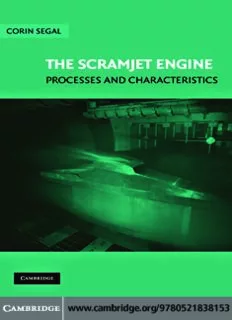
The Scramjet Engine: Processes and Characteristics (Cambridge Aerospace Series) PDF
Preview The Scramjet Engine: Processes and Characteristics (Cambridge Aerospace Series)
This page intentionally left blank THE SCRAMJET ENGINE PROCESSESANDCHARACTERISTICS The renewed interest in high-speed propulsion has led to increased activityinthedevelopmentofthesupersoniccombustionramjetengine for hypersonic flight applications. In this flight regime, the scramjet engine’s specific thrust exceeds that of other propulsion systems. This book,writtenbyaleadingresearcher,describestheprocessesandchar- acteristics of the scramjet engine in a unified manner, reviewing both theoretical and experimental research. The focus is on the phenom- ena that dictate the thermoaerodynamic processes encountered in the scramjetengine,includingcomponentanalysesandflow-pathconsidera- tions;fundamentaltheoreticaltopicsrelatedtointernalflowwithchem- icalreactionsandnonequilibriumeffects,high-temperaturegasdynam- ics,andhypersoniceffectsareincluded.Cycleandcomponentanalyses are further described, followed by flow-path examination. Finally, the bookreviewsthecurrentexperimentalandtheoreticalcapabilitiesand describesground-testingfacilitiesandcomputationalfluiddynamicfacil- itiesdevelopedtodateforthestudyoftime-accurate,high-temperature aerodynamics. AftercompletinghisPh.D.attheUniversityofVirginiain1991,Corin Segal took a teaching position at the University of Florida in the MechanicalandAerospaceDepartment,wherehenowleadsresearchin theCombustionandPropulsionLaboratory.Priortohisgraduatestud- ies, Dr. Segal spent more than 11 years in the aerospace industry as a senioraerodynamicistandprojectmanagerandasaleaderofthetech- nicalbureau.HiscurrentresearchattheUniversityofFloridacoversa range of topics, including mixing and combustion in high-speed flows, supercriticalmixing,high-pressurecombustion,andcavitation.Results ofhisgroup’sresearchhaveappearedinnationalandinternationalpub- lications.Dr.SegalisanassociateeditoroftheAIAAJournalofPropul- sionandPowerandanassociateFellowofAIAA. CambridgeAerospaceSeries Editors WeiShyyandMichaelJ.Rycroft 1. J.M.RolfeandK.J.Staples(eds.):FlightSimulation 2. P.Berlin:TheGeostationaryApplicationsSatellite 3. M.J.T.Smith:AircraftNoise 4. N.X.Vinh:FlightMechanicsofHigh-PerformanceAircraft 5. W.A.MairandD.L.Birdsall:AircraftPerformance 6. M.J.AbzugandE.E.Larrabee:AirplaneStabilityandControl 7. M.J.Sidi:SpacecraftDynamicsandControl 8. J.D.Anderson:AHistoryofAerodynamics 9. A.M. Cruise, J.A. Bowles, C.V. Goodall, and T.J. Patrick: Principles of SpaceInstrumentDesign 10. G.A.KhouryandJ.D.Gillett(eds.):AirshipTechnology 11. J.Fielding:IntroductiontoAircraftDesign 12. J.G.Leishman:PrinciplesofHelicopterAerodynamics,2ndEdition 13. J.KatzandA.Plotkin:LowSpeedAerodynamics,2ndEdition 14. M.J.AbzugandE.E.Larrabee:AirplaneStabilityandControl:AHistory oftheTechnologiesThatMadeAviationPossible,2ndEdition 15. D.H. Hodges and G.A. Pierce: Introduction to Structural Dynamics and Aeroelasticity 16. W.Fehse:AutomaticRendezvousandDockingofSpacecraft 17. R.D.Flack:FundamentalsofJetPropulsionwithApplications 18. E.A.Baskharone:PrinciplesofTurbomachineryinAir-BreathingEngines 19. D.D.Knight:NumericalMethodsforHigh-SpeedFlows 20. C.Wagner,T.Hu¨ttl,andP.Sagaut:Large-EddySimulationforAcoustics 21. D. Joseph, T. Funada, and J. Wang: Potential Flows of Viscous and ViscoelasticFluids 22. W. Shyy, Y. Lian, H. Liu, J. Tang, and D. Viieru: Aerodynamics of Low ReynoldsNumberFlyers 23. J.H.Saleh:AnalysesforDurabilityandSystemDesignLifetime 24. B.K.Donaldson:AnalysisofAircraftStructures,2ndEdition 25. C.Segal:TheScramjetEngine:ProcessesandCharacteristics The Scramjet Engine PROCESSES AND CHARACTERISTICS Corin Segal UniversityofFlorida CAMBRIDGE UNIVERSITY PRESS Cambridge, New York, Melbourne, Madrid, Cape Town, Singapore, São Paulo, Delhi, Dubai, Tokyo Cambridge University Press The Edinburgh Building, Cambridge CB2 8RU, UK Published in the United States of America by Cambridge University Press, New York www.cambridge.org Information on this title: www.cambridge.org/9780521838153 © Corin Segal 2009 This publication is in copyright. Subject to statutory exception and to the provision of relevant collective licensing agreements, no reproduction of any part may take place without the written permission of Cambridge University Press. First published in print format 2009 ISBN-13 978-0-511-65110-6 eBook (NetLibrary) ISBN-13 978-0-521-83815-3 Hardback Cambridge University Press has no responsibility for the persistence or accuracy of urls for external or third-party internet websites referred to in this publication, and does not guarantee that any content on such websites is, or will remain, accurate or appropriate. Information regarding prices, travel timetables, and other factual information given in this work are correct at the time of first printing, but Cambridge University Press does not guarantee the accuracy of such information thereafter. Contents Preface pagexi ListofAcronyms xv 1 Introduction . . . . . . . . . . . . . . . . . . . . . . . . . . . . . . . . . . . . 1 1.1 TheRamjetandtheSupersonicCombustionRamjet (Scramjet)EngineCycle 1 1.2 HistoricalOverview 4 1.3 Summary 12 References 14 2 TheoreticalBackground . . . . . . . . . . . . . . . . . . . . . . . . . . . 16 2.1 FieldEquationsandConstitutiveRelationsfor CompressibleFlows 16 2.1.1 FieldEquationsofFluidMotion 16 2.1.1.1 MassConservation 17 2.1.1.2 MomentumConservationEquations 17 2.1.1.3 ConservationofEnergy 18 2.1.1.4 ConservationofSpecies 18 2.1.2 ConstitutiveEquations 18 2.1.2.1 EquationsofState 19 2.1.2.2 TheFourierLawforHeatTransfer 19 2.1.2.3 TheShear-StressTensor 19 2.2 One-DimensionalSteadyFlowandtheRankine–Hugoniot Relations 20 2.2.1 One-DimensionalSteadyFlow 20 2.2.2 TheRankine–HugoniotRelations 22 2.2.3 ReservoirConditionsandThermalChokingin Constant-AreaDucts 23 v vi Contents 2.3 ChemicalReactionsandEquilibrium 25 2.3.1 ThermodynamicRelationsandtheGibbsFunction 25 2.3.2 ChemicalEquilibrium 26 2.3.3 TheLawofMassActionandReaction-Rate Constants 28 2.3.4 AirEquilibriumComposition 30 2.4 NonequilibriumConsiderations 32 References 33 3 High-TemperatureGasDynamicsandHypersonicEffects . . . . . 35 3.1 Introduction 35 3.2 Real-GasEquationofState 36 3.3 ElementsofKineticTheory 37 3.3.1 Pressure,Energy,andtheEquationofState 37 3.3.2 MeanFreePath 40 3.3.3 MaxwellianDistribution–VelocityDistribution Function 42 3.3.4 TransportCoefficients 44 3.4 ElementsofStatisticalThermodynamics 46 3.4.1 MicroscopicDescriptionofGases 47 3.4.1.1 ModesofEnergy 47 3.4.1.2 QuantumEnergyLevelsandDegeneracies 49 3.4.1.3 EnumerationofMicrostatesandthe Macrostate 51 3.4.2 CountingtheNumberofMicrostatesforaGiven Macrostate 51 3.4.3 TheMostProbableState 53 3.4.4 TheBoltzmannDistribution 53 3.4.5 ThermodynamicPropertiesinTermsof thePartitionFunction 54 3.4.6 EvaluationofthePartitionFunction 55 3.4.7 EvaluationofThermodynamicProperties 57 3.5 HypersonicFlow 59 References 61 4 CycleAnalysesandEnergyManagement. . . . . . . . . . . . . . . . .62 4.1 Introduction 62 4.2 IdealScramjetCycle 64 4.3 TrajectoryandLoads 68 4.4 PerformanceAnalysis 70 4.5 CombinedCycles 72 4.5.1 TheTurbine-BasedCombinedCycle–TBCC 73 Contents vii 4.5.2 TheRocket-BasedCombinedCycle–RBCC 75 4.5.2.1 RBCCSystems’ModeofOperation 76 4.5.2.2 Combined-CyclePropulsionTechnicalIssues 78 4.5.2.3 Mode-SpecificRBCCTechnicalIssues 79 References 82 5 InletsandNozzles . . . . . . . . . . . . . . . . . . . . . . . . . . . . . . . . 87 5.1 Inlets 87 5.1.1 Introduction 87 5.1.2 CompressionProcessEfficiencyandEnergetic Balance 90 5.1.2.1 PressureRecoveryandKineticEnergy Efficiency 90 5.1.2.2 ThePressureCoefficientK 93 WP 5.1.2.3 InletPerformance–Compressionand ContractionRatioEffects 95 5.1.3 FlowInteractionsandInletDesignConsiderations 98 5.1.3.1 InletStarting 98 5.1.3.2 ViscousInteractions 100 5.1.3.3 Shock–Boundary-LayerInteractions 103 5.1.4 AdvancedConceptsforInlet-FlowControl 106 5.1.4.1 IntakeAirEnergyManagement 106 5.1.4.2 FlowDecelerationUsingaMagneticField 107 5.1.4.3 FlowControlUsingFuelInjection 114 5.1.5 Summary 121 5.2 Nozzles 122 References 124 6 SupersonicCombustionProcesses. . . . . . . . . . . . . . . . . . . . .127 6.1 Introduction 127 6.2 TimeScales 128 6.3 Fuel–AirMixing 130 6.3.1 Parallel,Unbounded,CompressibleFlows 131 6.3.1.1 TheDefinitionoftheConvectiveMach Number 133 6.3.1.2 Two-DimensionalShear-LayerGrowth– VelocityandDensityDependence 135 6.3.1.3 CompressibilityEffectsonShear-Layer Growth 136 6.3.1.4 EffectsofHeatReleaseontheShearLayer 137 6.3.1.5 MixingWithintheShearLayer 138 6.3.2 MixingofAngledorTransverseFlows 139 viii Contents 6.3.3 DegreeofMixingandMixingEfficiency 148 6.3.4 MixingEnhancement 151 6.4 ChemicalKinetics–ReactionMechanisms 157 6.4.1 Hydrogen–AirReactionMechanisms 158 6.4.1.1 ReducedMechanismsforHydrogen–Air Combustion 163 6.4.2 ReactionMechanismsforHydrocarbons 165 6.4.3 Summary 170 6.5 FlameStability 171 6.5.1 Recirculation-RegionFlowField 172 6.5.2 Recirculation-RegionTemperature 174 6.5.3 LocalEquivalenceRatioAnalysis 176 6.5.4 Recirculation-RegionCompositionAnalysis 177 6.5.5 StabilityParameterFormulations 179 6.5.6 Summary 182 6.6 CombustionChamberDesignandHeat-ReleaseEfficiency 182 6.6.1 Isolator 183 6.6.2 CombustionChamberDesignandPerformance 187 6.6.2.1 GeneralChamberDesignParameters 187 6.6.2.2 PressureRiseandCombustionEfficiency 189 6.7 ScalingFactors 198 6.8 FuelManagement 201 6.8.1 FuelsasVehicleandEngineComponent CoolantAgents 201 6.8.2 ThermalversusCatalyticDecomposition 204 6.8.3 FuelManagement 206 References 207 7 TestingMethodsandWindTunnels . . . . . . . . . . . . . . . . . . . 215 7.1 Introduction 215 7.2 HypersonicFlightDomain 215 7.3 BlowdownFacilities 217 7.3.1 Combustion-HeatedWindTunnels 217 7.3.2 ElectricallyHeatedWindTunnels 219 7.3.3 Arc-HeatedFacilities 221 7.4 Short-Duration,Pulsed-FlowWindTunnels 222 7.4.1 ShockTunnels 222 7.4.2 Free-PistonShockTubes 224 7.4.3 ExpansionTubes 225 7.5 Summary 227 References 227
Description: